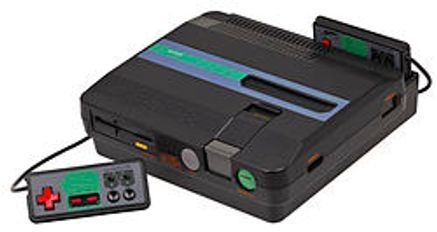


Twin Famicom
From Wikipedia, the free encyclopedia
(Redirected from Sharp Twin Famicom)
Twin Famicom Twin Famicom logo.svg
Sharp-Twin-Famicom-Console.jpg
The second version of the Sharp Twin Famicom in black
Manufacturer Sharp Corporation
Type Video game console
Generation Third generation (8-bit era)
Retail availability
JP: July 1, 1986
Media ROM cassette
Famicom Disk Card
Controller input 2 controller ports
The Twin Famicom (Japanese: ツインファミコン Hepburn: Tsuinn Famikon) is a video game console system that was produced by Sharp Corporation in 1986 and was only released in Japan. It is a licensed Nintendo product that combines the Family Computer (Famicom) and the Family Computer Disk System (FDS) into a single piece of hardware.
Overview
The basic parts of the Twin Famicom include a 60-pin slot for Famicom cartridges, a slot for Disk System's Disk Cards, a switch located right below the cartridge slot which allows the player to choose between "Cassette (カセット Kasetto)" or "Disk (ディスク Disuku)", the power button, reset button, and the eject buttons. FDS disks can be removed using the yellow button below the disk slot. The mechanism that it uses is similar to ones that are used in contemporary floppy disk drives. The eject button for cartridges is located between the power and reset buttons. It causes the cartridge to "pop" out of the slot, much like the way bread slices do when coming out of a pop-up toaster.
The system does not allow both slots to be used at the same time. The switch that changes the mode from disk to cartridge works in a manner in which choosing to use the cartridge slot will block the disk drive, and vice versa. However, in some systems, only the cartridge slot will be blocked, but it is impossible to change to cartridge mode while the disk is being read.
Specifications
Main Processor: Ricoh 2A03 at 1.79 MHz
RAM: 2 KB work RAM, 2 KB video RAM, 32 KB work RAM in FDS mode, 8 KB video RAM in FDS mode
ROM: FDS BIOS and 60-pin "cassette" (cartridge) slot
Audio: Six voices; two pulse wave channels, one triangle channel, one noise channel, one PCM channel, one 6-bit wavetable channel.
Graphics: Ricoh 2C02; 256×240 pixels, 64 sprites, can display 25 colors out of 53
Features
Red Twin Famicom variant
Like all other Famicom consoles, the Twin Famicom has a port that allows games like Moero TwinBee to support more than the usual two players and to which the matching version of the NES Zapper can be attached. There also is a second port of a slightly different shape for connecting another Famicom via the black RAM unit that comes with the standard Famicom Disk System. This allows a standalone Famicom to use the disk drive on the Twin Famicom.
Another unique trait of this console is its color. Whereas the original Famicom only came in one color combination, the Twin Famicom was initially sold in two colors: red with black highlights (AN-500R), and black with red highlights (AN-500B). A second version of the system was released in 1987 with a slightly different case design, turbo controllers, and two different color schemes; black with green highlights (AN-505-BK) and red with beige highlights (AN-505-RD).
Unlike the Famicom, which used an RF adapter, the Twin Famicom used RCA connectors for composite video and mono audio, allowing for greater audiovisual quality on TVs and monitors with such inputs. An external RF modulator was bundled with the unit for connection through a TV's antenna/cable input.










